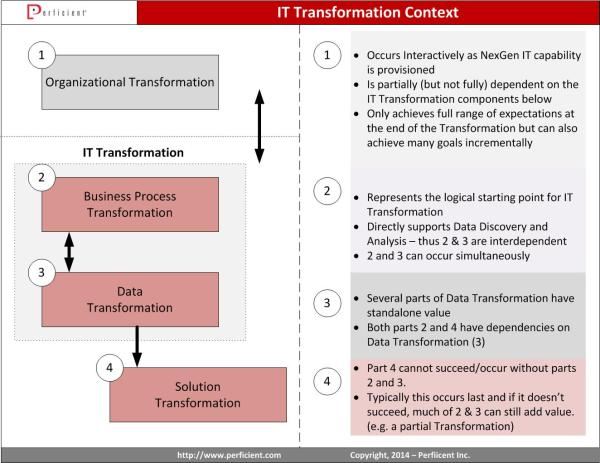IT Transformation has been a buzzword for more than a decade now, but what does it really mean? The first time I heard it used regularly was in relation to specific Department of Defense (DoD) technology initiatives from the early 2000s. I had the opportunity to work on several of those projects and as the years progressed the concept of IT Transformation evolved quite a bit – becoming much more flexible and yes – even somewhat Agile in nature.
At first IT Transformation was viewed from a more comprehensive perspective, sort of an organizational make-over if you will. This initial view involved Transformation at multiple levels and from multiple perspectives. This often included consolidation of organizational functions as well as IT systems and hosting capabilities – all at once. In some cases, IT Transformation was becoming almost synonymous with Enterprise Resource Planning (ERP) initiatives; in fact some people still view it that way.
The problem with the comprehensive view of IT Transformation though is its scope. As hard as it is to even get a project like that off the ground (funding, stakeholder buy-in etc.) successfully executing something that large is even more challenging – sort of the ultimate “Big Bang” approach. Despite that, Transformations are still hard to avoid – organizations that don’t adjust to changing realities and emerging technologies can rapidly become ineffective or redundant.
So, how does one approach Transformation in a way that can actually succeed? First we need to redefine it:
IT Transformation
“The set of activities required for an organization or group of related organizations to successfully adopt emerging capabilities and practice. This emerging technology or practice could be focused on one major capability or may involve multiple technologies and processes associated with a specific initiative.”
This definition allows us to view Transformation differently. Rather than the entire organization changing all at once we’re focusing now on areas of specific significant change. This Transformation based on significant enterprise change can be further decomposed into segments similar to the previous view of holistic Transformation (the business portion, the data portion, the solution portion etc.).
You might be asking yourself how this new view of Transformation differs from any other type of major IT initiative or project. The primary difference is that while today’s more Agile Transformation can be highly targeted it still exhibits these differentiating characteristics from typical IT projects:
- It is designed to fit into a larger set of Transformation goals (e.g. it comes pre-integrated, enterprise-aligned from day 1)
- It typically involves the combination of several distinct technologies and processes – moreso than other IT projects (because it is already enterprise or strategic-facing in nature)
- It typically is more mission-focused than many other IT projects. In other words, it has been selected to tackle a critical business issue, not just a technical concern.
Solution providers that support this new type of Transformation are somewhat more flexible in their perspectives on how to tackle complex Transformations than some of the more well-established consulting firms may be. While an ERP transformation may easily cost several hundred million dollars and still not succeed, Agile Transformation approaches look for smaller chunks of capability with higher ROI and success rates. We will highlight the primary Use Cases and several case studies for Agile Transformation in the coming months.
copyright 2014, Perficient Inc.

